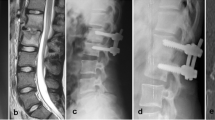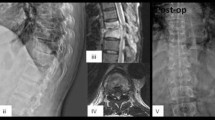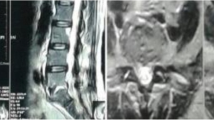Abstract
Background
In recent times due to the advancement of haemodialysis techniques, there is increase in the life span of the patients with end-stage renal disease, which tends to increase the risk of complications of bacteraemia due to skin penetration for blood access and leading to propensity for more skeletal and spinal complications. Hence, early diagnosis of spine infection and early initiation of appropriate therapy are important in ensuring successful treatment and preventing further morbidity.
Materials and Methods
The study included 22 males and 12 females who were known case of end-stage renal disease undergoing haemodialysis therapy and diagnosed with spondylodiscitis based on the clinical and radiological signs. The included patients required surgical stabilization based on the instability, neurological status, and epidural abscess, and non-responsive to medical line of treatment. To measure the degree of pain, Visual Analog Scale was used and British Medical Research Council grading system was used for motor evaluation. Radiography was undertaken one immediately and later at 1, 3, 9, and 12 months and at yearly interval thereafter. Fusion assessment was done by features of consolidation of graft and absence of loosening of implants in both anteroposterior and lateral views will be an indirect evidence of fusion in short-term follow-up.
Result
Average age of the patients was 62 years (range 40–75 years). Twenty-two patients were male (64.7%) and twelve (35.3%) were female. Sixteen patients had diabetes mellitus and fifteen patients had chronic glomerulonephritis with various underlying causes. All patients presented with back pain with a duration range from 3 to 8 weeks. 13 patients gave a history of on/off fever which was mild grade and 3 patients with high-grade fever. Eighteen patients presented with neurological deficits. The most common organism isolated was Methicillin-Resistant Staphylococcus Aureus (MRSA). At the final follow-up, radiographs revealed a good interbody fusion in 30 of the 34 cases, with 3 cases showed delayed fusion. The mean hemoglobin (Hb) level was 8.8 g/dl and elevated total leucocyte level with mean of 14,425; mean C-reactive protein (CRP) level was 55.6 mg/dl and erythrocyte sedimentation rate (ESR) was 47.5. All patients showed improvement in back pain. Preoperatively, the VAS had a mean of 8.5; post-operatively on day 2, the mean VAS was 3.2, and on 1 month follow-up mean VAS was 2.4.
Conclusion
In end-stage renal disease patients presenting with back pain, the diagnosis and treatment of spondylodiscitis becomes difficult. Where fever may not be a presenting feature even in cases with severe destructive osteomyelitis, and at times presenting as latent infection. Hence, spinal infection should be suspected as a possible cause of back pain in patients presenting with ESRD, even if they are presenting without fever and MRI study should be performed for the early diagnosis. Surgical intervention with debridement and posterior instrumentation should be considered as a modality of treatment in all cases of spondylodiscitis, with improved clinical outcome in terms of functionality, disability, and rehabilitation and acceptable complication rates in the perioperative period which can be adjusted to the individual cases.




Similar content being viewed by others
References
Adatepe, M. H., Powell, O. M., Isaacs, G. H., et al. (1986). Hematogenous pyogenic osteomyelitis: diagnostic valve of radionuclide bone imaging. Journal of Nuclear Medicine, 27, 1680–1685.
Albers, F. J. (1996). Clinical considerations in haemodialysis access infection. Adv Renal Replace Ther, 3, 208–217.
Chen, L.-H., Tsai-Sheng, Fu, Kao, Y.-H., et al. (2010). Surgical treatment of infectious spondylitis in patients undergoing hemodialysis therapy. European Spine Journal, 19, 2223–2228.
Marr, K. A. (2000). Staphylococcus aureus bacteremia in patients undergoing hemodialysis. Seminars in Dialysis, 13, 23–29.
Malawski, S. K., & Lukawski, S. (1991). Pyogenic infection of the spine. Clinical Orthopaedics, 272, 58–66.
Batson, O. V. (1940). The function of the vertebral veins and their role in the spread of metastases. Annals of Surgery, 112, 138–149.
Musher, D. M., Lamm, N., Darouiche, R. O., et al. (1994). The current spectrum of Staphylococcus aureus infection in a tertiary care hospital. Medicine, 73, 186–208.
Meyers, S. P., & Wiener, S. N. (1991). Diagnosis of hematogenous pyogenic vertebral osteomyelitis by using magnetic resonance imaging. Archives of Internal Medicine, 151, 683–687.
Tsuchiya, K., Yamaoka, K., Tanaka, K., et al. (2004). Bacterial spondylodiscitis in the patients with hemodialysis. Spine, 29, 2533–2537.
Bathon, J., Graves, J., Jens, P., et al. (1987). The erythrocyte sedimentation rate in end-stage renal disease. American Journal of Kidney Diseases, 10, 34–40.
McIntyre, C., Harper, I., Macdougall, I. C., et al. (1997). Serum C-reactive protein as a marker for infection and inflammation in regular dialysis patients. Clinical Nephrology, 48, 371–374.
Ishak, R., & Hassan, K. (1989). The erythrocyte sedimentation rate, C-reactive protein, plasma fibrinogen and viscosity in chronic renal disease patients with infection. Malaysian Journal of Pathology, 11, 29–31.
Carragee, E. J. (1997). The clinical use of magnetic resonance imaging in pyogenic vertebral osteomyelitis. Spine, 22, 780–785.
Sharif, H. S. (1992). Role of MR imaging in the management of spinal infections. American Journal of Roentgenology, 158, 1333–1345.
Carragee, E. J. (1997). Instrumentation of the infected and unstable spine: a review of 17 cases from the thoracic and lumbar spine with pyogenic infections. Journal of Spinal Disorders, 10, 317–324.
Author information
Authors and Affiliations
Corresponding author
Ethics declarations
Conflict of interest
The authors declare that they have no conflict of interest.
Ethical standard statement
This article does not contain any studies with human or animal subjects performed by the any of the authors.
Informed consent
For this type of study informed consent is not required.
Additional information
Publisher's Note
Springer Nature remains neutral with regard to jurisdictional claims in published maps and institutional affiliations.
Rights and permissions
About this article
Cite this article
Vinay Jain, K., Ravikumar, T.V. Surgical Management of Thoracolumbar Spondylodiscitis in End-Stage Renal Disease. JOIO 55 (Suppl 1), 176–181 (2021). https://doi.org/10.1007/s43465-020-00132-4
Received:
Accepted:
Published:
Issue Date:
DOI: https://doi.org/10.1007/s43465-020-00132-4




